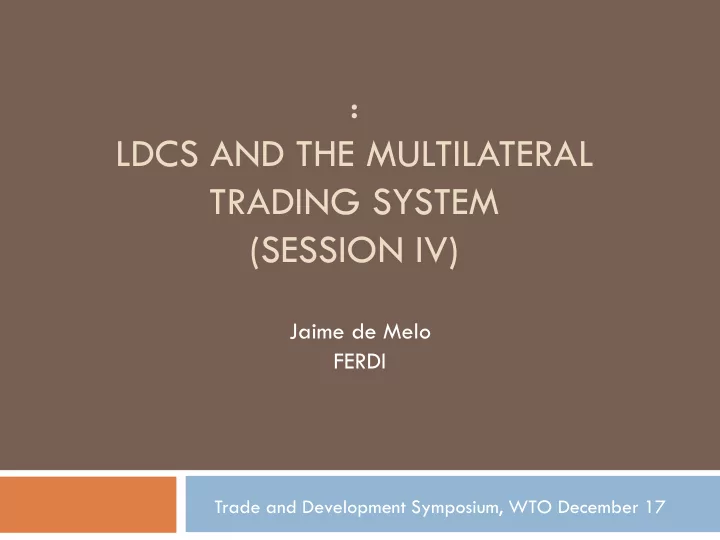

: LDCS AND THE MULTILATERAL TRADING SYSTEM (SESSION IV) Jaime de Melo FERDI Trade and Development Symposium, WTO December 17
TPFD is "giving away with one hand (preferences) and taking away with another (restrictive RoO)" 2 Market Access LDCs from zero duty for 97 percent of tariff lines Simplification of Rules of Origin for increased market access Based on 2004 data for US and EU imports but results broadly applicable now More results reported in Journal of World Trade (2010) 44(1), 251-90 The Doha Round and Market Access for LDCs: Scenarios for the EU and US Markets Céline Carrère and Jaime de Melo And on two FERDI Blogs http://www.ferdi.fr/uploads/sfCmsContent/html/111/B24-I-Carrere- deMelo.pdf http://www.ferdi.fr/uploads/sfCmsContent/html/111/B24-II-Carrere- deMelo.pdf
LDCs exports by main markets 3
Cumulative Tariff Barriers in the EU 4 total of 9427 HS8 lines, 1.36% (1.24%) of lines have an MFN (ACP) tariff higher than 50%
Cumulative Tariff Barriers in the US 5 Note : total of 5113 HS6 lines, 0.25% of lines have an MFN tariff higher than 50%.
How Much Preferential Access (EU-27)? 6
Negative Preferential Access for LDCs in US! 7
Cumulative exports against cumulative Preferences (Lorenz-type curve-EU-27)) 8
Cumulative exports against cumulative Preferences (Lorenz-type curve-US) 9
Applying the 3% exclusion benchmark on US tariff lines 10 Table 5: Selection of US Tariff lines for exclusion from duty-free status for LDC (HS6 leve Source: authors’ computations. Notes: a) Excluded: see annex A.2.3 for description of exclusion from duty-free status for LDC; b) Non Excluded: lines with zero tariff for US imports from LDCs.
Supply response of LDC exports (Partial equilibrium estimates) 11 Table 6: LDC Export expansion from “97%” duty-free status proposal Source: authors’ computations. Note: Increase from total initial LDC exports to the US (US$ 11,433 million
Rules of Origin 12 complex and vary greatly across sectors generally more stringent for the products with the highest preference margins • Different across countries for the same tariff line • EU has over 500 Product-specific RoO !!!! • Countries do not want to simplify (even though the EU has followed on AGOA and removed triple transformation rule on textiles recently
An ordinal index of restrictiveness 13 Ordinal index computed at the HS-6 tariff line level R =1 Change of tariff classification at the tariff line R =4 CTC + other criterion (e.g. minimum VC) R=7 Multiple criteria Higher values of R correspond to more restrictive PSRO Following table shows that high preference margin products face restrictive PSRO
Table 7: LDC Preferential Margins and the PSRO index a 7a: EU Nber of lines with Weighted Average Weighted Average positive LDC export Preference margin R-Index value Preferential Margin peaks b 570 17.13% 6.08 824 0.01% Low Preferential Margin b 3.19 Total number of tariff lines 3509 4.64% 3.93 Notes: a /LDC as a group b/ the Preferential Margin tariff peaks are defined for tariff lines with preference margins in excess of 12% and low margins for tariff lines below 1% preferential margins. Source: authors’ computations. 7b: US Nber of lines with Weighted Average Weighted Average positive LDC export Preference margin R-Index value Preferential Margin peaks b 267 8.08% 6.64 1009 0.002% Low Preferential Margin b 6.10 Total number of tariff lines 1783 0.86% 6.33 Notes: a /LDC as a group b/ the Preferential Margin tariff peaks are defined for tariff lines with preference margins in excess of 3% and low margins for tariff lines below 0.05% preferential margins. 14
PSRO index against preferential margin (219 countries) 15
US PSRO index against preferential margin (219 countries) Maldives Lesotho Cambodia 7 Haiti Bangladesh Myanmar Nepal Madagascar Lao PDR Malawi Vanuatu Uganda Cape Verde Comoros Mozambique Burundi Equatorial Guinea Guinea Ethiopia(excludes Eritrea) Afghanistan Liberia Sudan Bhutan Tanzania Guinea-Bissau Rwanda 6 Angola Kiribati Samoa Solomon Islands East Timor Sierra Leone Central African Republic Yemen Eritrea Zambia Chad Burkina Faso Somalia Mauritania Congo, Dem. Rep. Senegal Benin Gambia, The Mali 5 Niger Sao Tome and Principe Togo Djibouti 4 3 2 0 5 10 15 20 Weighted average of Preference margin 16
Conclusions (1) 17 Preferential access is greater in the EU than the US (where T&A are excluded from preferential status except for AGOA beneficiaries) as LDCs virtually have DFQF access to the EU market Taking into account that the EU and the US are both engaged in FTAs with countries that compete with the LDCs diminishes substantially the effective preferential margin received by LDCs to about 3% in the EU market Taken as a group, .on a trade-weighted basis, the LDC group is discriminated against in the US market, this in spite of AGOA which gave DFQF access to 22 LDCs from SSA in 2004. Thus, as a group, i.e. if they were considered to be one country, the 50 LDCs are getting less preferential access in the US market than other exporters of the goods exported by the LDCs.
Conclusions (2) 18 Should DOHA come to a successful ending in the sense that tariffs are reduced according to a “Swiss formula”, effective preferential access to LDCs will be negligible in the EU and still negative in the US. If the US were to apply the “97% rule”, LDC might increase exports to the US by about 10% or about $1billion. RoO applied by the US and the EU to GSP beneficiaries are complicated and different even when defined at the HS-6 line level. This implies that an LDC exporting any product will have to meet different requirements for different destinations thereby adding costs to exporting. The PSRO applied by the EU and US are complex. They reduce further the effective market for LDCs in the EU and US markets.
Recommend
More recommend